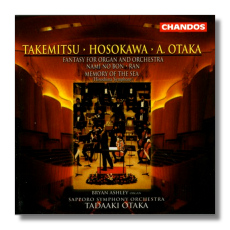
The Internet's Premier Classical Music Source
Related Links
- Latest Reviews
- More Reviews
-
By Composer
-
Collections
DVD & Blu-ray
Books
Concert Reviews
Articles/Interviews
Software
Audio
Search Amazon
Recommended Links
Site News
 CD Review
CD Review
Takemitsu / Hosokawa / Otaka

Orchestral Music
- Atsutada Otaka: Fantasy for Organ and Orchestra
- Tōru Takemitsu:
- Nami no Bon
- Ran
- Toshio Hosokawa: Memory of the Sea (Hiroshima Symphony)
Bryan Ashley, organ
Sapporo Symphony Orchestra/Tadaaki Otaka
Chandos CHAN9876 DDD 78:40
There is curious programming afoot here: the Takemitsu scores are melodic and absolutely approachable, but the longer works by Otaka and Hosokawa demand much more from the listener. I'm not necessarily convinced by the juxtaposition. Nevertheless, everything on this disc is worth hearing, so take this CD in steps, as I eventually did.
The Fantasy for Organ and Orchestra is by the conductor's brother Atsutada Otaka. A pupil of Duruflé, Otaka was inspired by the sound of a Parisian organ throughout the composition of this work. With its alternation of quiet and meditative passages with frighteningly noisy ones, Otaka's 28-minute Fantasy reminds me of Poulenc's Concerto for Organ, Strings, and Timpani, at least in its structure. Otaka's use crunchy, clustery dissonances distinguish it from Poulenc's work, but what characterizes both works seems to be their eagerness to shock – a little! Hearing Otaka's Fantasy made me think of the pale modern teenagers who favor dark lipstick and eyeshadow, but who really want to be loved. American-born organist Bryan Ashley, now a staple in Japan, creates a massive sound on the Sapporo Concert Hall's French-style organ.
Toshio Hosokawa's Memory of the Sea is a portrait of nature's resiliency and persistence, even in the face of man-made disasters such as the atomic bomb. The conductor writes, "[Hosokawa] wanted to express in music the sound of the sea, light, smell, moving clouds, and the breeze of Hiroshima in his memory." This work, which is nearly 20 minutes long, is primarily sonoristic: melody, per se, is subservient to timbres and washes of color. The orchestral percussionists are given plenty to do. Two groups of instruments are separated from the orchestra to generate "a three-dimensional echo effect." This is difficult to realize without visual input. It is an attractive score, although it seems lengthy for its material.
Nami no Bon was a television drama; Ran, of course, is one of Kurosawa's greatest films. Takemitsu wrote some of his most conventional music for film. These scores, however, are not marginal, and they add necessary detail to any portrait of this great Japanese composer. Nami no Bon is presented as a six-movement suite – the composer's? The conductor writes, "It is my wish that many people should discover this particularly romantic and affecting theme created by Takemitsu." Indeed, it could be the composer's "A Time for Us," should someone set English words to it. The music from Ran is presented in four movements, for a total of 12 minutes. Of course this is only a fraction of the score. It would be worth your while to track a more complete representation down.
The Atsutada Otaka and Hosokawa scores are receiving their first recordings here. Tadaaki Otaka's conducting is a good advocate for this unfamiliar music, as well as for the Takemitsu scores. The Sapporo Symphony Orchestra plays beautifully, and the production/engineering team of Tony Harrison and Mike Hatch gets stunning results.
Copyright © 2001, Raymond Tuttle


















